Scrol naar beneden om de gehele documentatie te bekijken.
Please scroll down this page to see the documentation in total.
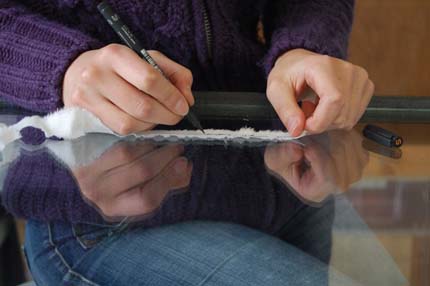
Het begin van dit project: Feathernotes-zinnen op stroken stof over vergeving.
At the start: Feathernotes-sentences on strokes of fabric about forgiveness.

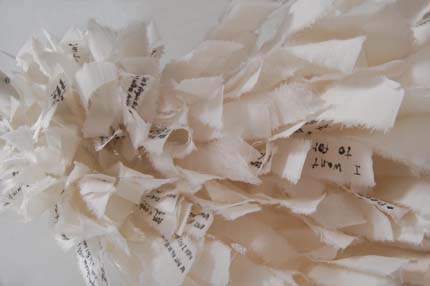
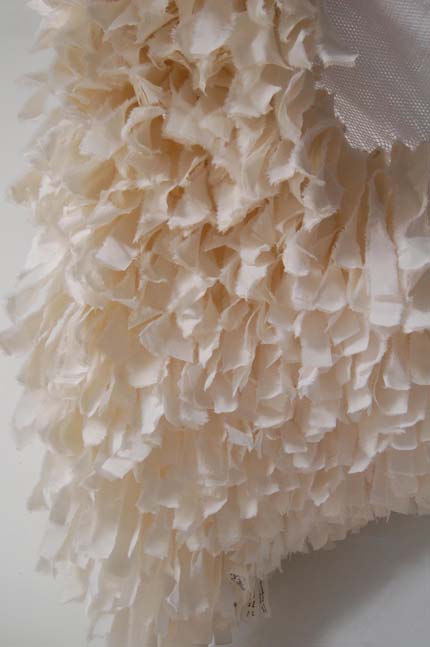

In de Ein Gedi woestijn in Israel. De sjaal beloofde een mooi object te worden; misschien maak ik hem nog af als ik verder ben in dit onderzoek. Toen ik er mee bezig was viel het mij tegen dat het onderwerp 'vergeving' zo zwaar bleek te zijn voor veel mensen. Ik verwachtte een zekere spontaniteit in de reacties, maar ontving veel beschouwingen die van een algemene wijsheid getuigden, en veel minder die persoonlijke openheid in zich hadden. Maar wel zeker zinnen die bijzondere invalshoeken over het thema vergeving meebrengen; knap! Later trok ik de conclusie dat een uitspraak over een ethische questie totaal geen makkie is, en dat daar een heel gesprek bij hoort, met inhoudelijke zijtakken voor creatieve zuurstof. Zie de 'quotes' link voor de zinnen die mensen (in het Engels) schreven.
At the Ein Gedi desert in Israel. The scarf seemed to become a beautiful object; maybe I'll finish it later on during this research. When I was busy with it, it disappointed me that the subject 'forgiveness' appeared to be so loaded for people. I aspected a certain spontaniousness in the reactions, but received a lot of statements that showed a global wisdom, and less that contained personal openness. But for sure there where sentences written that brought original views on the theme forgiveness; great! Later on I concluded that a statement about an ethical issue isn't easy at all, and that it comes with a complete discussion, with substantive sidecomments for creative oxygen. See the 'quotes' link for the sentences that people wrote (in English).
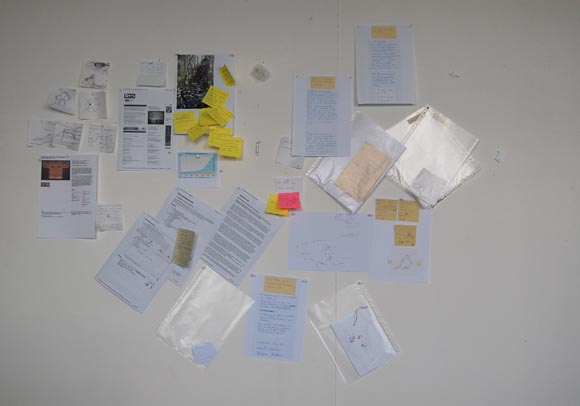
Naar aanleiding van de gesprekken die ik had met mensen over vergeving groeide mijn onderzoeksvraag de breedte in. Vergeving raakte namelijk vooral op een abstracte manier mijn eigenlijke vraag: hoe geven we elkaar de ruimte? Ik werd juist geraakt door de dingen die mensen zich hardop begonnen af te vragen of als anekdote vertelden, maar niet opschreven; daarin kwam een persoonlijke ervaring tot leven die mij verraste. Ik wilde dat soort opmerkingen kunnen benutten als transfers: ze aan anderen tonen en hen op die manier even in contact brengen met de bronpersoon die het had bedacht of het zich afvroeg. De volgende ontmoetingen kregen daarom meer de vorm van een brainstorm/interview/workshop.
Because of the conversations that I had with people about forgiveness I expanded the research. Forgiveness dealt with my actual question only in an abstact way: how can we give eachother space? I was touched by the things people where wondering or narrating about, but which they didn't write down; a personal experience became alive out of it, which surprised me. I wanted to use those remarks as some kind of transfers: to show them to others and by that way bringing others in contact with the person that had occured them. The following meetings got more the form of a brainstorm/interview/worksession.

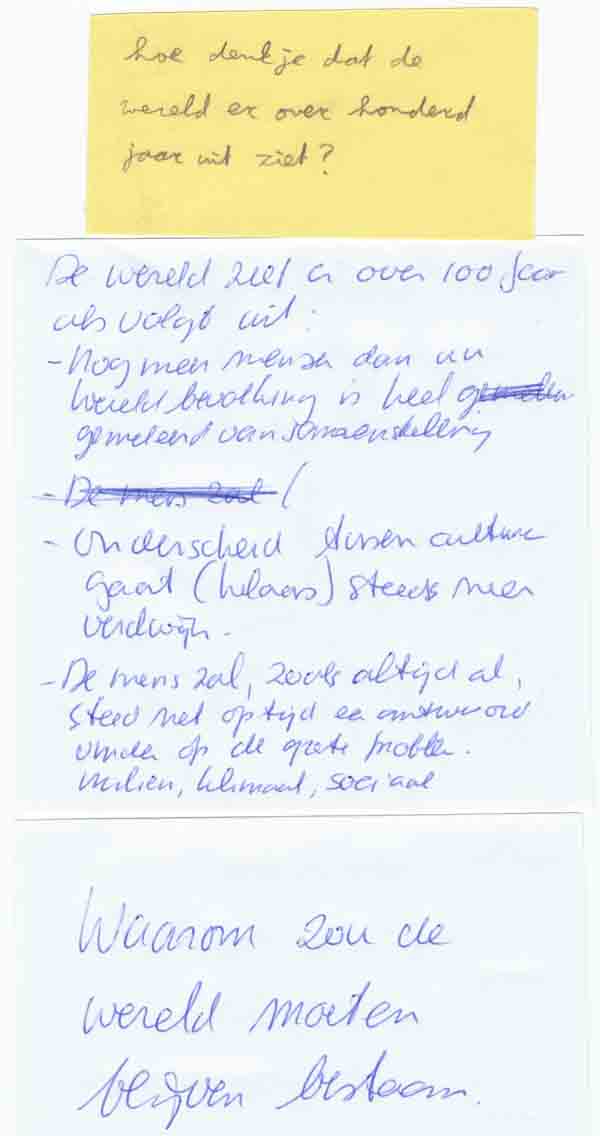
Na dat ik een tijd gesproken had met iemand in mijn atelier, vroeg ik diegene om zelf een vraag te formuleren, voor anderen.
At the end of a conversation in my studio, I asked the person to write a question to others.
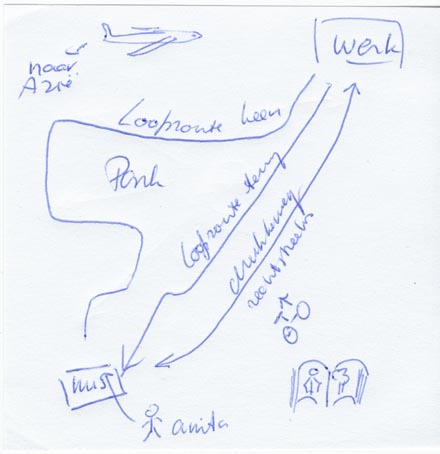
Hoe ziet de plattegrond van jouw leven er op dit moment uit?
Ik vroeg of mensen dat in een simpel tekeningetje konden schetsen. En om vervolgens op een overtrekpapiertje een lijn te trekken om de dingen waarin ze zich het meest thuis voelden. Het leverde diverse thuisen op:
What does the map of your live look like at this moment?
I asked people to draw it in a simple sketch. And to draw a line on a transferpaper around the things in which they feld at home the most. It led to several homies:
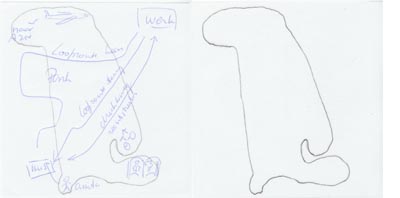
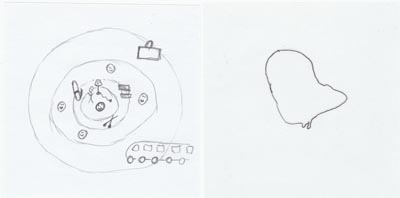

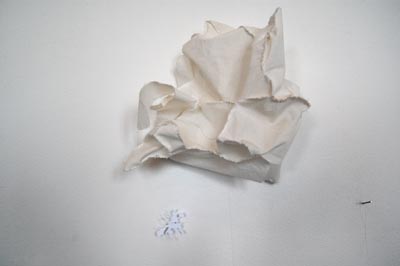
Ik heb enkele thuisen uitvergroot, uit stof geknipt, en als patroondelen gebruikt, als test. Dit zou een nieuw kledingstuk kunnen worden.
I enlarged some homies, cut them out of fabric, and used them as a pattern, to test it. It could become a new piece of cloth.
Get Flash to see this player.
Dit filmpje is een collage van enkele Feathernotes-gesprekken. Ik nam de genodigde mee naar het dak van mijn atelier, vanwaar je veel huizen ziet. Ik vroeg de persoon om een huisje te kiezen en te vertellen wat zijn/haar fantasie erover was: wie woont er, wat doet diegene, hoe is het interieur, hoe ruikt het er, wat voor sfeer hangt er? Opvallend vond ik dat op mijn laatste vraag, "Zou je zelf diegene willen zijn?", de meeste mensen stellig "nee" antwoordden.
Misschien dat we op de ander, een onbekende, eerder geneigd zijn onze kwetsbare, minder positieve beelden van de maatschappij te projecteren zo lang we de persoon in kwestie niet hebben zien leven?
Vanuit mijn atelier heb ik het voorrecht om honderden vogels bezig te zien met hun landen en vertrekken. Wij gebruiken de vogel vaak als symbool voor vrijheid, maar hun persoonlijke ruimte lijkt onderling bijna een enkel wezen te vormen..
This video is a collage of several Feathernote-conversations. I brought people to the roof of my studio, from where one has a great view on the city, and asked them to pick a house and tell me their fantasies about the content of it: what kind of person might live there, what's the interior like, what's the atmosphere, etc.
It turns out that most imagined lives where not admired by the viewer.. Maybe we project our social worries more easy on people that are abstract to us?
The birds that are starting their journey in front of my studio always make me think: they have all the space in the world (at least we see them as a symbol of freedom), and yet they stay close together as if they form one body.
De mensen die ik sprak vroeg ik ook om een pluisje van hun eigen kleding aan mij te geven. Ik heb de pluisjes gefotografeerd. Ik vind het bijzonder hoe zo een klein textielobjectje toch al zo kan verschillen per persoon.
I asked the people that I spoke with to give me a tiny flock of their own clothes. I took pictures of the flocks; it amazes me how such small objects can be so personal diverse.
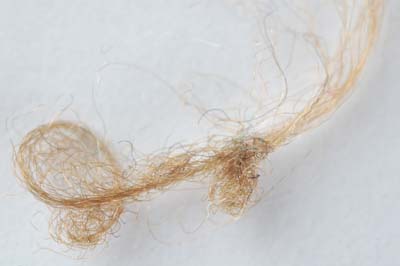

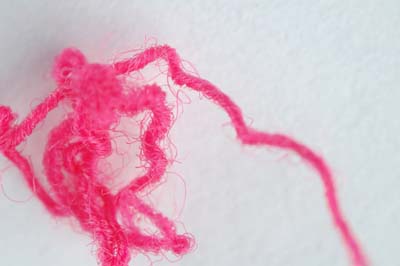

Eenzaamheid
De pluisfoto hier onder heb ik op stof laten drukken en daar een trui van gemaakt. Zo draag ik eigenlijk een stukje persoonlijke ruimte van iemand anders; van een Canadese kunstenares om precies te zijn.
Loneliness
The photo below was printed on fabric and I made a sweater out of it to wear myself. In that case I'm actually wearing a part of the personal space of someone else's; of the canedian artist that gave me the flock on the photograph.
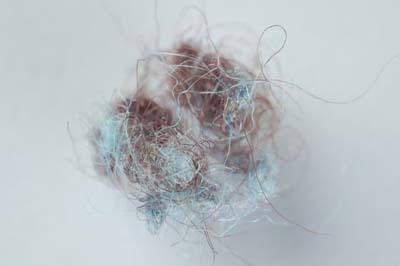
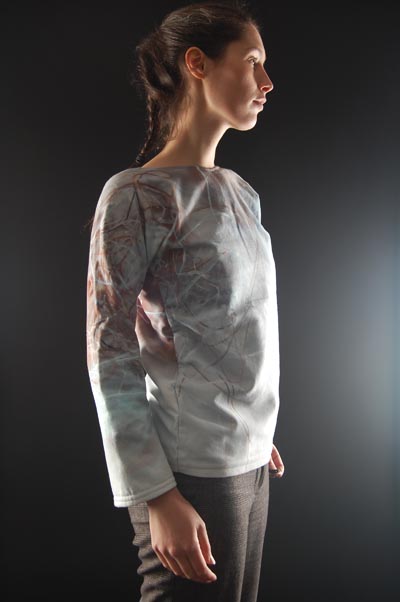

Op de trui staat de vraag die aan haar werd gesteld: "Hoe kun je omgaan met eenzaamheid?"; haar antwoord daar op: "Develop a passion for something in the world out there. Be engaged with some activity that will keep you connected to other people."; en de vraag die zij stelde: "Will screentime take over our lives or has it already?".
On the sweater is an embroidery-text with the question that was asked to her: 'How can you deal with loneliness?", her answer to that: "Develop a passion for something in the world out there. Be engaged with some activity that will keep you connected to other people."; and the question that she asked in return: "Will screentime take over our lives or has it already?".
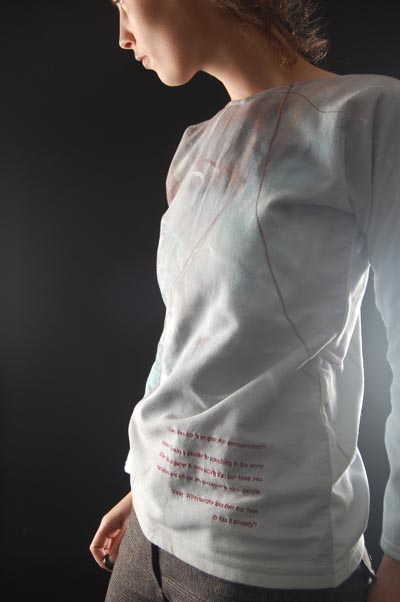
Veel vragen
Het pluisje hier onder komt van een gebarentolk. De trui die er uit is ontstaan bevat vragen van meerdere mensen, en vraagt enige handelingen van de drager (zie filmpje).
Many questions
The flock below comes from a sign language interpreter. The sweater that came out of it keeps questions of several people, and requires some activity by the person that's wearing it (see video).

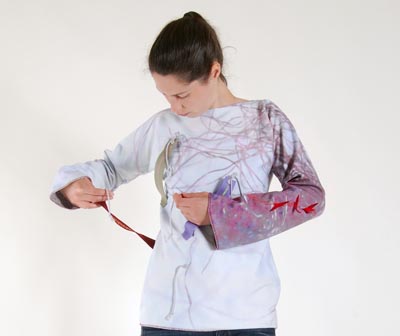
Get Flash to see this player.
De vragen zijn geborduurd op de binnenzijde van stroken vilt, die opengeknoopt kunnen worden om de tekst leesbaar te maken voor anderen. Op de binnenkant van de trui staan meer uitgebreide teksten geschreven; de trui is dus aan twee kanten draagbaar.
"Is het mogelijk om met militair geweld een conflict te beslechten met positief resultaat?", "Kun je je herinneren dat je je bewust was dat je iets leerde en wat was dat?", "Waarom zou de aarde moeten blijven bestaan?", "Wat denk en voel je bij een psychiatrische patient?"
The questions are embroidered on the inside of strokes of vilt, wich can be tied open to make the text readable to others. On the inside of the sweater there are more extensive texts written; so the sweater can be worn at two sides.
"Is it possible to solve a conflict on a military way with positive result?", "Can you remember that you were aware of the moment that you were learning something and what was that?", "Why should the earth keep on existing?", "What do you think and feel about a psychiatric patient?".
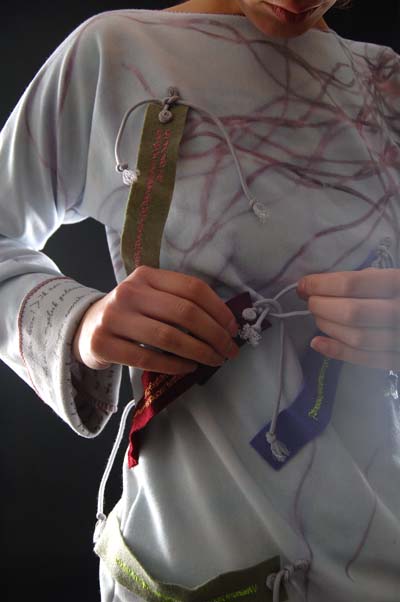
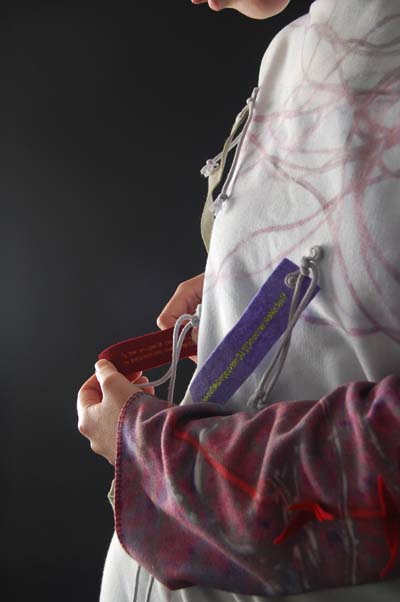
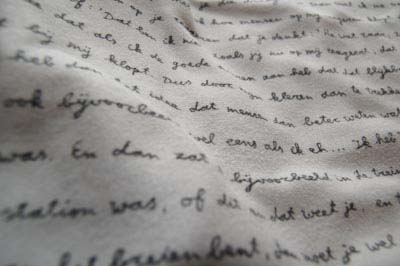
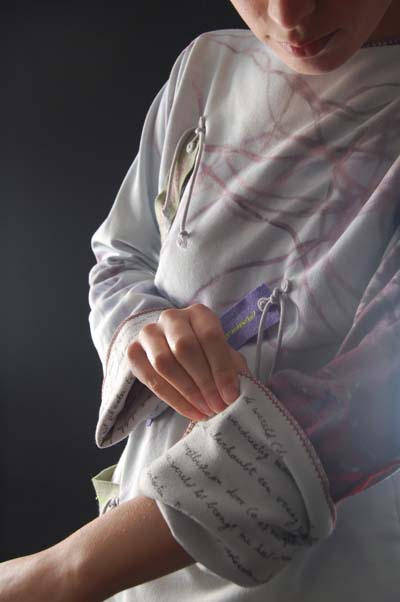
Aan de binnenzijde van de trui heb ik delen van Feathernotes-gesprekken met de hand opgeschreven: op de romp in directe spreektaal (compleet met eh's en tja's), over persoonlijke ervaring met de eerste kledingstukken die mensen waren bijgebleven. En op de mouwen (in meer geredigeerde zinnen) hun visies over het delen van ruimte. (Zie de 'quotes' link voor de teksten).
At the inside of the sweater I wrote parts of the Feathernotes-conversations by hand: at the torso-part in pure speakinglanguage (with hmm's, you know's etc.), about personal experiences with early clothes that stayed in people's memory. At the sleeves (in more edited sentences) peoples visions on sharing space. (See the 'quotes' link for the texts.)
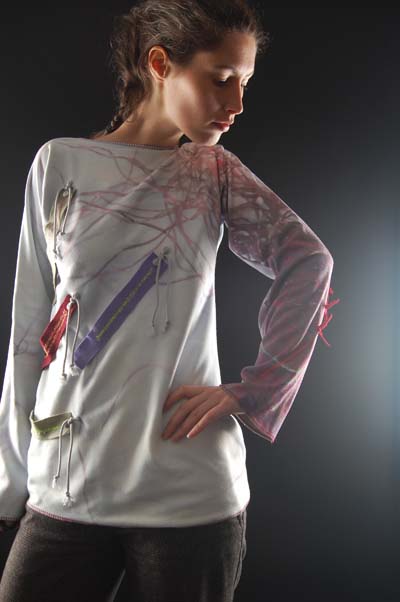
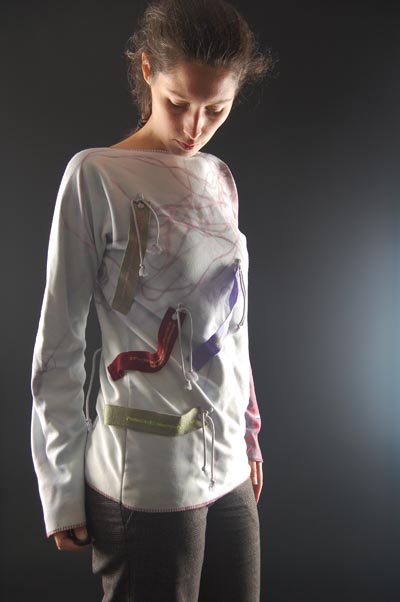
Globe
Op een moment dat ik over dit project tamelijk in twijfeling was kwam ik in de gelegenheid om te exposeren, in een groeps-expositie in de tentoonstellingsruimte Nest, in het zelfde pand als waar mijn atelier is. Ik besloot om ondanks mijn twijfels toch werk hier voor te maken dat gerelateerd is aan Feathernotes; het zou dan een kijkje in de keuken bieden.
Ik had op dat moment geen duidelijk genoeg beeld bij Feathernotes om een stabiel werk te maken met een statement, of iets dergelijks. Het is dan ook een heel voorzichtig zoekend werk geworden. Het is een mobile, met de naam 'Globe', verwijzend naar een vaststaand wereldbeeld. Deze globe is echter totaal niet vaststaand, niet rond en niet wetenschappelijk onderzocht maar juist intuitief ontstaan.
Met een beetje fantasie kun je een schommelend of paraglidend persoon in het geheel ontwaren (lichaam van zwarte takjes, koepel van houten takjes)..
Globe
I got the opportunity to expose work in the same building as where I have my studio in. At that moment I was very insecure about this project, but decided to present something about it anyhow, since the presentation was close to my studio one could see it as a glimpse of a process.
At that moment Feathernotes was quite unstable to me and I guess that was the reason for a searching, balancing work. It's a mobile, named 'Globe', reacting on the idea of a stable worldview. But this globe is not stable at all, it isn't round, and not proven scientificly, rather based on intuition.
With some fantasy one can see a person sitting on a swing, or paragliding (body made by black sticks, kite made of wooden sticks)...
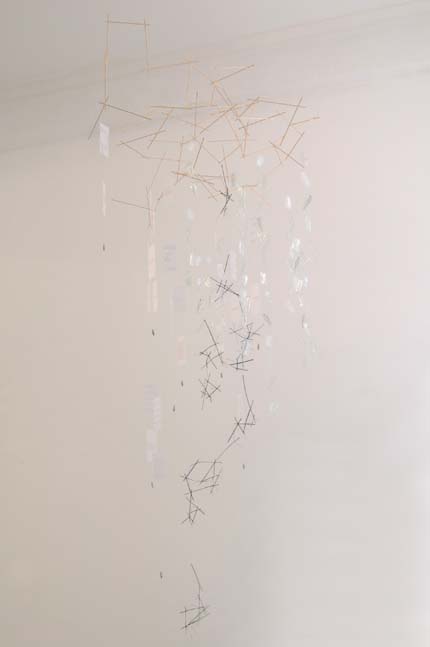
Aan een open constructie van sateestokjes hangen kaartjes, met daarop de handschriftfragmenten en de vragen en antwoorden van mensen die ik heb gesproken voor Feathernotes.
On an open construction of wooden sticks there are cards hanging with fragments of handwriting and the questions and answers by people that I have spoken with.
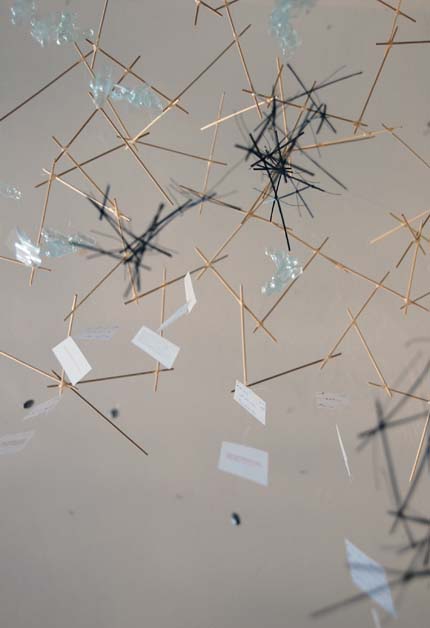

Ook hangen er slierten met kleine transparante mens-units (gemaakt van batterijverpakking) in de mobile. Voor mij illustreert dit dat ieder mens in een afschermende gevoelsruimte leeft, die weliswaar informatie doorlaat, maar heel beperkt is als je er niet actief aan werkt.
In the mobile there are also strings hanging with small trantsparant human-units (made out of wrappings of batteries). To me this illustrates that every human has his own emotionalspace, which allows information exchange, but stays very limited if one doesn't work on it actively.
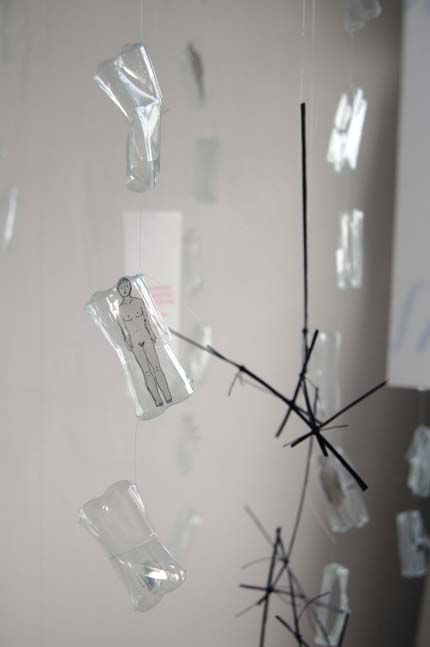
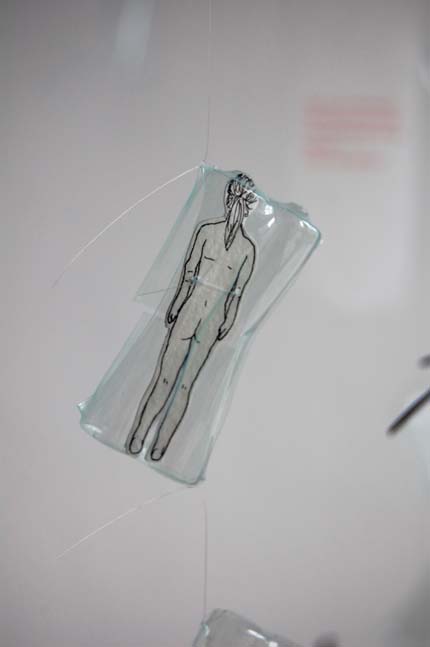

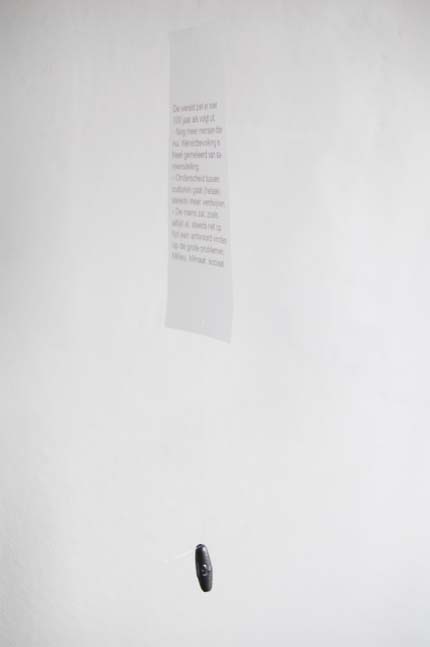


Get Flash to see this player.
De mobile gefilmd met zonlicht in de lens.
The mobile filmed with sunlight-glamour in the lens.
Trui over psychiatrische patienten
Sweater about psychiatric patients
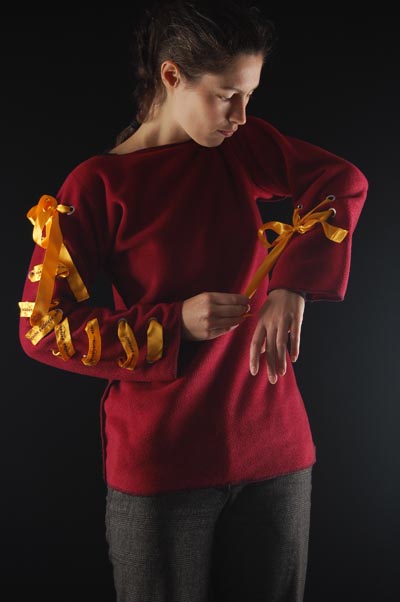

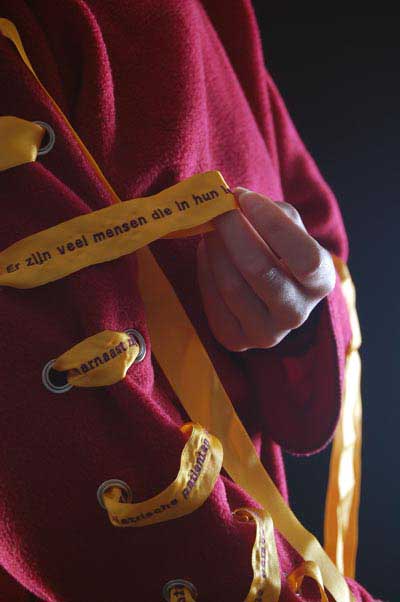
"Er zijn veel mensen die in hun leven psychische problemen hebben. Daarnaast zijn er ook ernstig zieke psychiatrische patienten met bijvoorbeeld angststoornissen, ernstige persoonlijkheidsproblematiek, depressies, schizofrenie... etc. Wat denk en voel jij bij een psychiatrische patient?", was de vraag van een psychiater in opleiding.
Met deze trui heb ik geprobeerd om een minder complex beeld neer te zetten, dat de aandacht meer direct op de tekst richt, en sneller opvalt. Als mensen de vraag willen lezen moeten ze echter wel heel dicht bij mij komen en komt het 'delen van ruimte' subtiel aan de orde.
"There are many people who have psychical problems during their lives. There are also seriously ill psychiatric patients with for instance anxiety disorder, serious personality problems, depressions, schizofrenia etc... What do you think and feel according to a psychiatric patient?", was questioned by a woman that was to become a psychiatrist.
With this sweater I tried to make a less complex image, that might caught the attention more easy and focus more on the text. If people want to read the sentence they have to get close to me and the 'sharing of space' occurs in a subtile way.
Laatste update: 20 september 2010
Last update: September 20th 2010